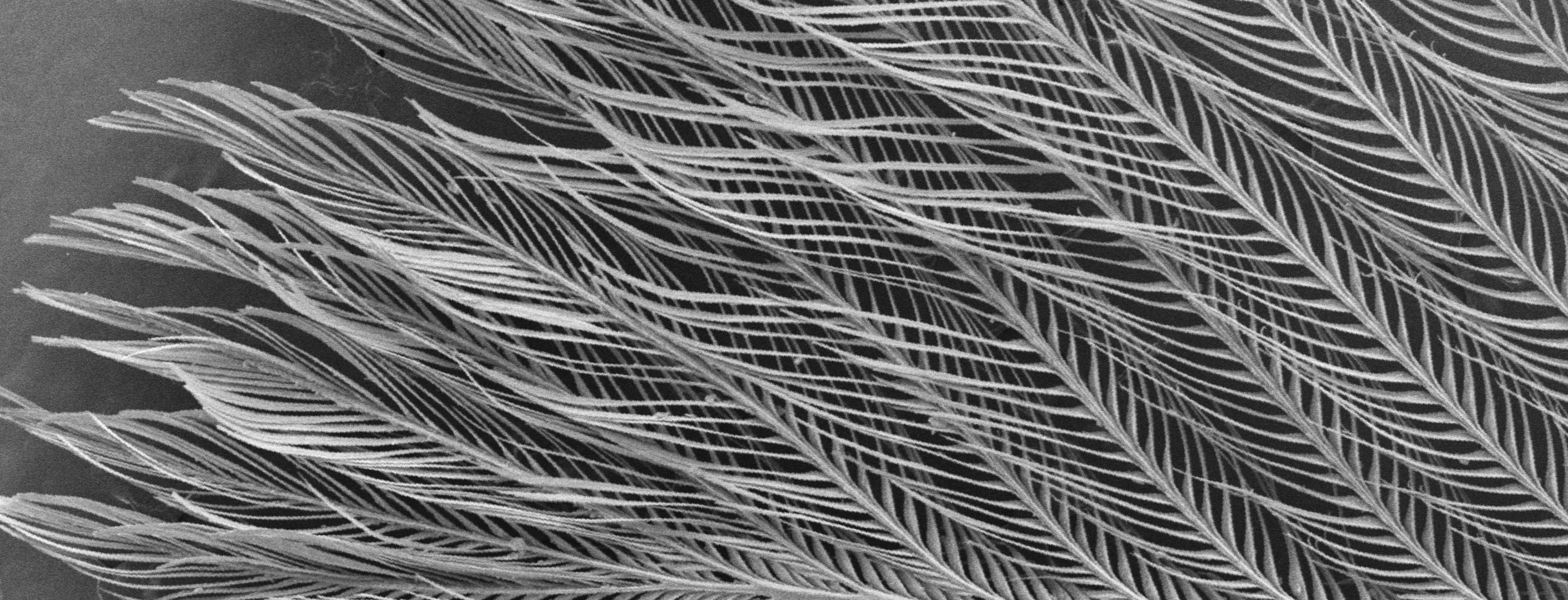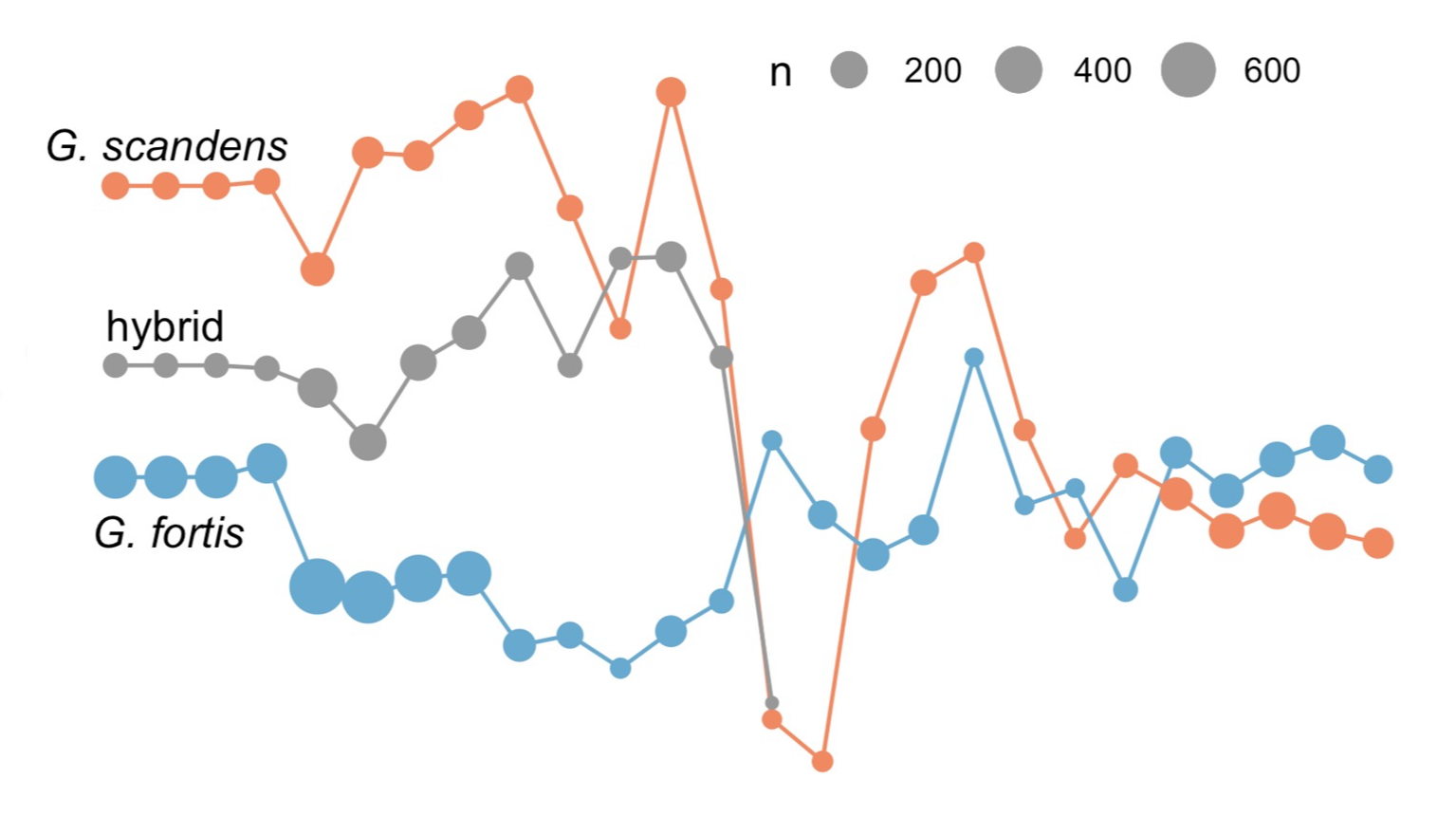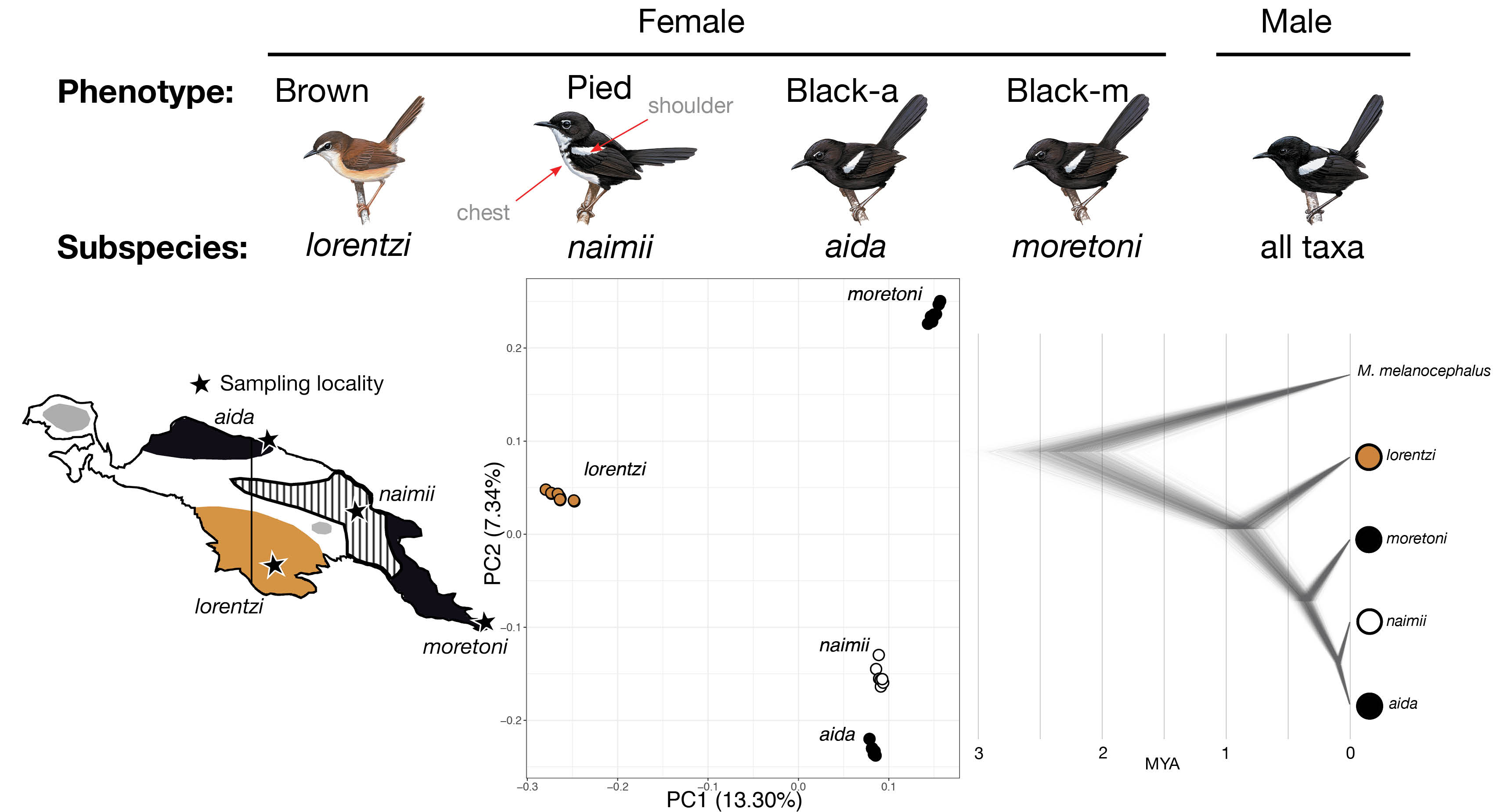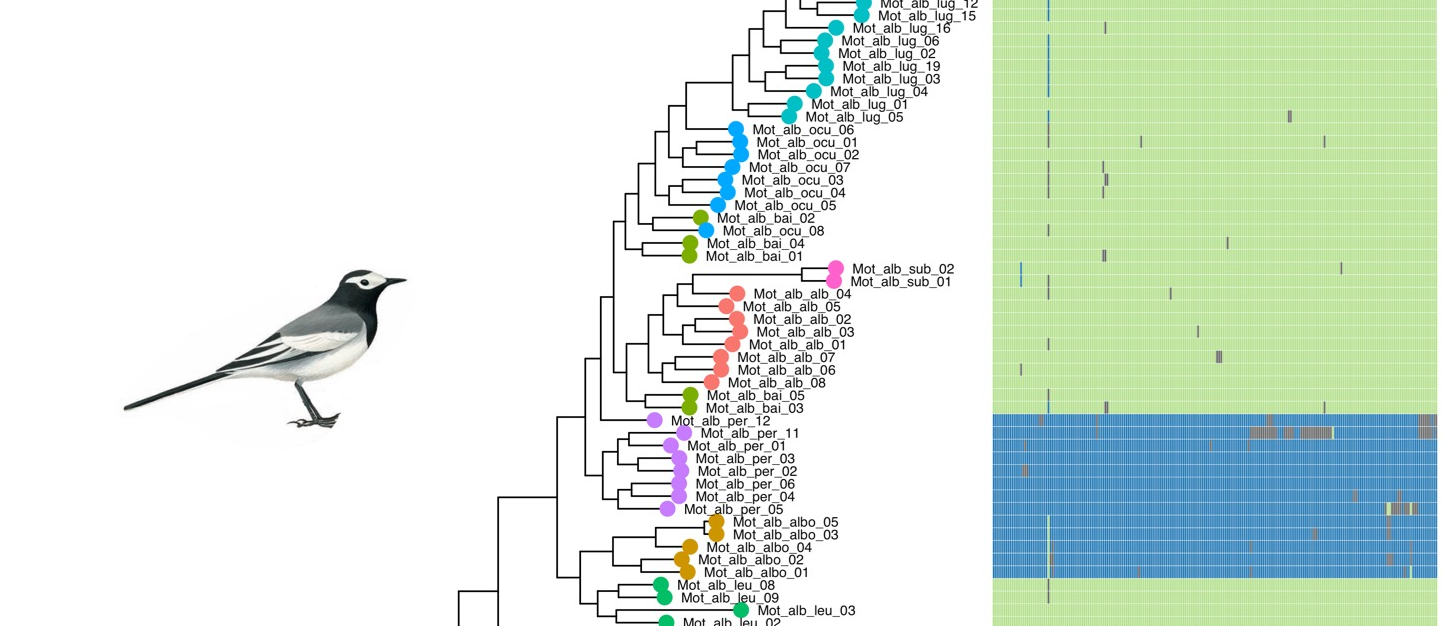
Erik Enbody
I am an evolutionary biologist trained in bioinformatics, field ecology, and behavioral research. My research is driven by my fascination with the evolutionary processes that generate diversity in wild populations. This research includes projects on birds, mammals, and fish from the Americas, Eurasia, and Oceania.
Currently, I am the bioinformatics postdoc lead on the California Conservation Genomics Project where I build frameworks for processing and comparing massive comparative genomic datasets (10s of thousands of samples). My work is further motivated by the pressing need to remove systemic exclusionary and colonialistic practices in my field, which is reflected in my service work at home and abroad.
My current affiliation is a Postdoctoral Scholar in Genomics & Bioinformatics in the Corbett-Detig lab at the University of California Santa Cruz. I previously worked as a Postdoctoral Scholar in Leif Andersson’s lab at Uppsala University. I completed my Ph.D. in 2018 at Tulane University in Dr. Jordan Karubian's lab and received my bachelor's in biology from Colorado College.
ContactResearch
California Conservation Genomics Project

I am the bioinformatics lead on the California Conservation Genomics Project . This consortium aims to produce the most comprehensive multispecies genomic dataset ever assembled to help manage and protect regional biodiversity in the face of climate change. I lead the bioinformatics team to carry out comparative genomics analyses for conservation applications and a viable pipeline for high throughput analysis in the cloud of massive genomic datasets. Interested in variant calling at scale? Check out our pipeline snpArcher.
Wooldridge, B., C. Orland, E.D. Enbody, M. Escalona, C. Mirchandani, R. Corbett-Detig, J.D. Kapp, Nathaniel Fletcher, K. Ammann, P. Raimondi, B. Shapiro. under review. Limited genomic signatures of population collapse in the critically endangered black abalone (Haliotis cracherodii) biorxiv preprint
Mirchandani, C.D., A.J. Shultz, G.W.C. Thomas, S.J. Smith, M. Baylis, B. Arnold, R. Corbett-Detig†, E.D. Enbody†, T. B. Sackton†. 2024. A fast, reproducible, high-throughput variant calling workflow for evolutionary, ecological, and conservation genomics. Molecular Biology and Evolution 41(1) GitHub link
Genomics of the Darwin’s Finch radiation

My research program leverages this unique system of Thraupidae finches on the Galapágos Islands to investigate the link between fitness and genetic variation. The basis for this research has involved the generation and analysis of 4,000 Darwin’s finch genomes derived from individually marked finches collected over 40 years on Daphne Major by Drs. Peter and Rosemary Grant. This project required the development of methods to use low-coverage (2x) data to estimate population allele frequencies from wild populations. Using this dataset, we can identify and track through time functional variants related to natural variation.
E.D. Enbody, A.T. Sendell-Price, C. G. Sprehn, C.J. Rubin, P.M. Visscher, B.R. Grant, P.R. Grant, L. Andersson. 2023. Community-wide genome sequencing reveals 30 years of Darwin’s finch evolution Science 381(6665).
C.J. Rubin†, E.D. Enbody†, M.P. Dobreva, A. Abzhanov, B.W. Davis, S. Lamichhaney, M. Pettersson, A.T. Sendell-Price, C. G. Sprehn, C.A. Valle, K. Vasco, O. Wallerman, B.R. Grant, P.R. Grant, L. Andersson. 2022. Rapid adaptive radiation of Darwin’s finches depends on ancestral genetic modules Science Advances. 8(27) .
E. D. Enbody, C.G. Sprehn, A. Abzhanov, H. Bi, M.P. Dobreva, O.G. Osborne, C.J. Rubin, P.R. Grant, B.R. Grant, L. Andersson. 2021. A multispecies BCO2 beak color polymorphism in the Darwin’s finch radiation. Current Biology .
Grant, P.R., R. Grant, E. D. Enbody, L. Andersson, S. Lamichhaney. 2020. Darwin’s finches, an iconic adaptive radiation. eLS. 1:672–682 .
(† denotes equal contribution)
Evolution of female ornamentation in the White-shouldered Fairywren

My dissertation research focused on evaluating evidence for the role of selection in the evolution of female plumage ornamentation in the White-shouldered Fairywren of New Guinea. In this species, different populations vary in the degree of ornamentation in female but not male plumage. I used the White-shouldered Fairywren as a model to test hypotheses for the evolution of female ornamentation, because the degree to which selection (sexual or otherwise) acts on female ornamentation is both poorly understood and controversial.
In this international collaboration, we have described the evolutionary history of the various White-shouldered Fairywren subspecies, examined evidence for selection on female ornamentation using genomics, and the proximate mechanisms shaping signal production. This work was generously funded by an NSF Dissertation Improvement Grant.
Boersma, J., E.D. Enbody , S. Ketaloya, H. Watts, J. Karubian, H. Schwabl. 2023. Does capacity to elevate androgens underlie variation in female ornamentation and territoriality in White-shouldered Fairywren (Malurus alboscapulatus)?. Hormones & Behavior. 154(105393). .
Sin, S.Y.W., F. K., G. Chen, P.-Y. Huang, E.D. Enbody , J. Karubian, M. S. Webster, S. V. Edwards. **submitted manuscript**. Genetic basis and evolution of structural color polymorphism in an Australian songbird. Link to preprint .
Khalil, S., E.D. Enbody , C. Frankl, J.F. Welklin, R.E. Koch, M.B. Toomey, S.Y.W. Sin, S.V. Edwards, M. Gahr, H. Schwabl, M.S. Webster, J. Karubian. 2023. Testosterone coordinates gene expression across different tissues to produce carotenoid-based red ornamentation. Molecular Biology and Evolution. 40(4): msad056.
Boersma, J., Enbody, E.D, J. Karubian, H. Watts, H. Schwabl. 2022. Drought disrupts year-round breeding readiness in a tropical songbird. Avian Conservation and Ecology. 17(2):44.
Enbody, E.D, Sin, S.Y.W., Boersma, J., Schwabl, H., Edwards, S.V., Webster, M.S., Karubian, J. 2022. The evolutionary history and mechanistic basis of female ornamentation in a tropical songbird. Evolution. 76(8):1720–1736.
Boersma, J., E.D. Enbody, J.A. Jones, E. Lopez-Contreras, J. Karubian, H. Schwabl. 2020. Exogenous testosterone induces partial ornamentation which enhances vocal aggression in a female tropical songbird. Behavioral Ecology. 31(5):1233-1241.
Javůrková, V.G., E.D. Enbody, J. Kreisinger, K. Chmel, J. Mrázek, J. Karubian. 2019. Plumage iridescence is associated with distinct feather microbiota in a tropical passerine. Scientific Reports (12921).
Enbody, E.D., J. Boersma, J. A. Jones, M. W. H. Chatfield, S. Ketaloya *, D. Nason *,D. T. Baldassarre, J. Hazlehurst, O. Gowen, H. Schwabl, J. Karubian. 2019. Social organization and breeding biology of the White-shouldered Fairywren Malurus alboscapulatus. Emu: Austral Ornithology. 19(3): 274-285. Special issue: Ornithology of New Guinea and the Indo-Pacific Islands. (invited contribution & cover photo).
Enbody, E.D., J. Boersma, H. Schwabl, J. Karubian. 2018. Female ornamentation is associated with elevated aggression and testosterone in a tropical songbird. Behavioral Ecology. 29(5): 1056–1066.
Enbody, E.D., Lantz S.M., and J. Karubian. 2017. Production of plumage ornaments among males and females of two closely related tropical passerine bird species. Ecology and Evolution. 00:1-11.
Brouwer, L., M. van de Pol, N. H. Aranzamendi, G. Bain, D. T. Baldassarre, D. Colombelli-Négrel, E.D. Enbody, K. Gielow, M. L. Hall, A. E. Johnson, J. Karubian, S. A. Kingma, S. Kleindorfer, M. Louter, R.A. Mulder, A. Peters, S. Pruett-Jones, K. A. Tarvin, D.J. Thrasher, C.W. Varian-Ramos, M.S. Webster, A. Cockburn. 2017. Multiple hypotheses explain variation in extra-pair paternity at different levels in a highly variable avian family. Molecular Ecology. 26:6717–6729.
Adaptation to diverse environments in marine organisms

In many marine fish systems huge population sizes provide a powerful model for population genomics analysis aimed at understanding how populations adapt to different local environmental conditions. In one study, we described a recent selective sweep driven by a missense mutation in fish rhodopsin that facilitates adaptation to the red-shifted light environment in Baltic Sea herring and has occurred >20 times in other fish transitioning to freshwater environments. In contrast to the Atlantic Herring, the European eel exhibits an unusual life history where breeding occurs in the central Atlantic Ocean, but all adults spend their life in continental Europe in environments ranging from warm to cold and brackish to freshwater. Considerable disagreement in the literature has failed to demonstrate if continental eel populations represent a single panmictic population or consist of populations locally adapted to their environment. We use whole genome analysis from hundreds of individuals to solve this enigma and were able to compellingly demonstrate that the predominant mechanism that allow eels to inhabit diverse environments is plastic and not genetic.
Pettersson, M.E., A. P. Fuentes-Pardo, C. M. Rochus, E.D. Enbody, H. Bi, R. Väinölä, L. Andersson. 2023. A long-standing hybrid population between Pacific and Atlantic herring in a subarctic fjord of Norway. Genome Biology and Evolution. 15(5): evad069.
Liu, H., C. Chen, M. Lv, N. Liu, Y. Hu, H. Zhang, E.D. Enbody, Z. Gao, L. Andersson, W. Wang. 2021. Comparative genomic analysis reveals ecological adaptation of teleost olfactory receptor repertoires. Molecular Biology & Evolution: msab152.
Erik D. Enbody†, M.E. Pettersson†, C. Grace Sprehn, S. Palm, H. Wickström, L. Andersson. 2021. Ecological adaptation in European eels is based on phenotypic plasticity. Proceedings of the National Academy of Sciences. 118(4): e2022620118. .
Gustafsson, R., U. Eckhard, W. Ye, E.D. Enbody, M. Pettersson, P. Jemth, L. Andersson, M. Selmer. 2020. Structure and characterization of phosphoglucomutase 5 from Atlantic and Baltic herring - an inactive enzyme with intact substrate binding. Biomolecules. 10(2):1631. .
Hill, J., E.D. Enbody, M.E. Pettersson, C.G. Sprehn, D. Bekkevold, A. Folkvord, L. Laikre, G. Kleinau, P. Scheerer, L. Andersson. 2019. Recurrent convergent evolution at amino acid residue 261 in fish rhodopsin. Proceedings of the National Academy of Sciences. 116(37): 18473-18478. Press: PNAS In This Issue, Science Daily, phys.org, Sveriges Radio.
(† denotes equal contribution)
Plumage evolution

artwork: Bill Zetterström
I use genomics to study the evolution of plumage coloration in Motacilla wagtails and other birds. The wagtails group of colorful passerine birds are common across Europe, Asia, and Africa. Several species are charecterized by large variation in plumage coloration, but little genetic divergence. We leverage these features to study the processess that have generated such dramatic variation in plumage signals.
Hill†, J., E.D. Enbody†, H. Bi†, S. Lamichhaney, D. Schwochow, S. Younis, F. Widemo, L. Andersson. 2023. Low mutation load in a supergene underpinning alternative male mating strategies in ruff. Molecular Biology and Evolution. .
Rancilhac, L., E.D. Enbody, R. Harris, T. Saitoh, M, Irestedt,Y. Liu, F. Lei, L. Andersson, P. Alström. 2023. Introgression underlies phylogenetic uncertainty but not parallel plumage evolution in a recent songbird radiation. Systematic Biology. .
Turbek, S.P., G. A. Semenov, E.D. Enbody, L. Campagna, S.A. Taylor. 2021. Variable signatures of selection despite conserved recombination landscapes early in speciation. Journal of Heredity .
Semenov, G.A., E. Linck, E.D. Enbody, P. Alström, L. Andersson, D.R. Khaydarov, S.A. Taylor. 2021. Asymmetric introgression reveals the genetic architecture of a plumage trait. Nature Communications: 1019. .
Genomic resources

I have led or contributed to the generation of novel resources for genomic studies on non-model species. These state of the art genome assemblies are chromosome scale and include high quality genome annotations.
- White Wagtail: Motacilla alba
- Small Tree Finch: Camarhynchus parvulus
- European Rabbit: Oryctolagus cuniculus (in progress)
- Ruff: Calidris pugnax (in progress)
- White-shouldered Fairywrren: Malurus alboscapulatus (in progress)
Our group has worked to refine a high-throughput library preperation technique for creating WGS libraries at cost: roughly $2/sample at 400 samples per day. We wrote up our protocol on protocols.io:
Speaking

I have given talks at numerous international conferences about my research on evolutionary biology, behavioral ecology, and genomics. Please send me an email if you are looking for a seminar speaker on any of these topics!
Below is a recent talk about my research on Darwin's Finches at the virtual 2020 North American Ornithological Congress
Fieldwork
Papua New Guinea

Research abroad is made possibly through working with local communities. I have worked with local communities in New Guinea to advocate for and develop a locally led group dedicated to grassland conservation. In New Guinea, the goal of our project was to support the idea that conservation is not just for the community, but by the community as well.
Watch a video summary of our work in Garuahi, Milne Bay Province: